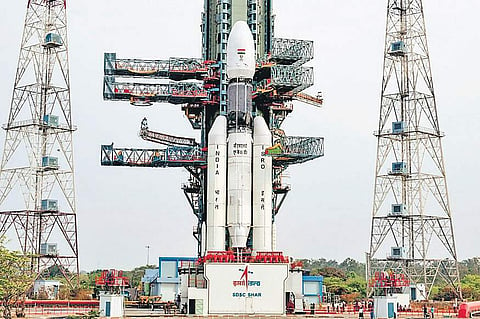

CHENNAI: As the countdown begun for the launch of GSLV MkIII-D2 mission scheduled to lift-off from Sriharikota on Wednesday evening, stakes are raising high as the ‘fat boy’ is shouldering a mountain of hope and aspiration of people of hilly and geographically inaccessible areas of North East and Jammu and Kashmir.
The rocket payload GSAT-29, a very advanced high-throughput satellite weighing a whopping 3,423 kg, is configured to cater to the communication requirements of users from Jammu and Kashmir and North Eastern regions of India. ISRO officials said the satellite’s Ku and Ka band communication payloads are designed to mainly focus on providing high throughput connectivity to a large population of the country, besides acting as test bed for demonstrating new and critical technologies with certain strategic importance.
K Sivan, chairman, ISRO told Express on the eve of the launch that GSAT-29 will demonstrate for the first time Q/V-band payload and data transmission through optical communication link, which will help the space agency realise future advanced satellites. “Q/V-band payload will enhance the bandwidth 50 gigabytes and the data transmission through optical communication link will help establish a secured line between two satellites,” he said and refused to comment on whether optical communication link would give India a strategic advantage. “Our job is to develop technology and there would be multiple usages.”
GSAT-29 is a three axis stabilised geostationary satellite configured on ISRO’s enhanced 1-3K Bus. The satellite has a multiband, multi-beam payload, which is essentially meant for demonstrating new technologies. “GSAT-29 is also a forerunner of future advanced communication satellites of INSAT and GSAT series,” he said.
Also, GSAT-29 is one of the four high-throughput satellites, whose combination will propel the internet speed to a mind-boggling 100 gigabytes per second (Gbps) under Digital India programme. Out of the four, GSAT-19 is already been put in orbit earlier this year, while GSAT-11 is scheduled to be launched from Fresh Guiana on December 4 and GSAT-20 is being built and expected to be launched next year.
On the rocket, ISRO chairman said it was capable of lifting up to four tonne mass to Geosynchronous Transfer Orbit (GTO) or a 10 tonne payload to Low Earth Orbit. “This vehicle is powered by two S200 solid motors, one L110 liquid core stage and a powerful liquid cryogenic stage C25. This mission is second developmental flight of GSLV MkIII and this is the important mission for GSLV MkIII programme as after the success of this mission, GSLV MkIII will be declared as operational and will join the group of operational vehicles PSLV and GSLV,” he said.
GSAT-29 is planned to be injected into a GTO with its perigee at 190 km and apogee at 35,975 km. The Master Control Facility (MCF) at Hassan will take over the command and control of GSAT-29 soon after its separation from GSLV MKIII-D2.
The satellite orbit will be raised to the final circular Geostationary Orbit (GSO) by firing Liquid Apogee Motor in stages.